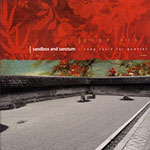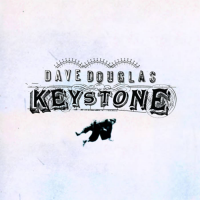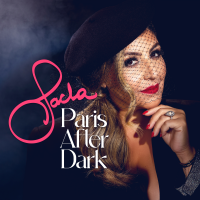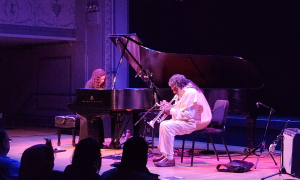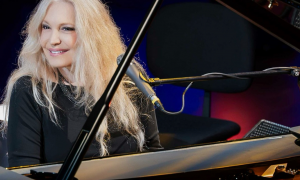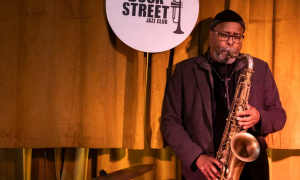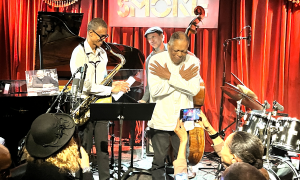Home » Jazz Articles » Live Review » Lisbon's Jazz em Agosto
Lisbon's Jazz em Agosto
At one time a more mainstream affair, under the guidance of artistic director Rui Neves, Jazz em Agosto has become a considerable showcase for innovative improvised music.
Dedicating the festival's opening performance to longtime member trombonist Albert Mangelsdorff, who died less than two weeks before the concert, Schlippenbach presented the big, bassless Globe Unity Orchestra (GUO) he first convened in 1966 for a rare appearance since their 2002 reunion. The pianist, two drummers and an octet of horns all seemed individually intent on not playing until they thought of something good and not letting too much time be spent thinking. The horn players would stop, look down the line, rock in place, laugh a little and jump back in while Schlippenbach and drummers Lovens and Lytton darted through syncopations. To pick out a highlight would be to imply (wrongly) that there were comparative low points. Nevertheless, solos by trombonists Rutherford and Bauer were lovely and explosive respectively, as if they felt especially closely the missing voice of Mangelsdorff. A particularly nice saxophone trio (Parker, Gerd Dudek and Ernst Ludwig Petrowsky) and an unravelled rag by the leader were also memorable.
Schlippenbach, Parker and Lovens weren't the core of the band, but did juxtapose themselves by playing as a trio the following night. And so nicely did Schlippenbach's soft-mallet pounding of the piano strings work with GUO that he did it again to open his trio's set, working the sustain pedal against resounding beats, setting a foundation for Parker and Lovens to consider in reeds and gongs. With careful placement of pot lids, Schippenbach created a beautiful rattle overlaid with quick melody lines. Like some of his fellow pianists at the fest, he doesn't just prepare for effect but makes it a different instrument and one he knows how to play.
Like Schlippenbach, Swiss pianist Schweizer plays with tradition while making sparse and tasteful use of the instrument's innards. Her oft professed love for playing duos with drummers and her long relationship with countryman Favre gave an ease to their set that felt almost composed. They started strong, as if the "play button had just been pushed, and shared a telepathic link for tempi, volume, even pauses. American pianist Maroney is usually more concerned with the piano's guts, but in trio with Dresser and Mike Sarin he showed a propensity for jazz keying, only occasionally reaching inside the case. The strength of the trio is that they are remarkably similar players: they all play percussively; all create prolonged tones that hang in the air; and they can become a piano trio at the drop of a hat. Swiss born pianist Courvoisier was more active inside the case; her trio Mephista with drummer Susie Ibarra and electronic percussionist Ikue Mori has become one of the best working bands in New York. Through focus
and touring they've reached that magical point of "yeah, we meant to do that improvisation, where elements seem predetermined if not preconceived. Mori was the only purely electronic musician at the festival, although a number of groups implemented laptops and processing as a part of their sound. A meeting of the Danish trio Sound of Choice and the French string quartet IXI presented slight, if nicely arranged, compositions. Likewise the Norwegian quintet Wibutee made precise, effective use of looping and samples, but without material to push them beyond a new century of lounge music. Drummer Jerry Granelli's V-16 pitted a father-and-son rhythm section against two electric guitars (replete with pedals) for a wandering set that incorporated, to varying degrees, Mingus, Otis Redding and a bit of bossa nova. The excellent Swiss trio Koch/Schutz/Studer seemed distracted by their circuits and cables for the first half of their set, only getting into their "hardcore chamber groove once they switched to acoustic cello and unprocessed horns (drummer Fredy Studer chugged along reliably, whatever his cohorts did). The most unusual use of electronics was an odd solo set by Portuguese pianist and journalist Jorge Lima Barreto, who played variations suggesting Cecil Taylor and Erik Satie against the squeals of a shortwave radio positioned next to him. The intention was hard to peg, but the contrast was refreshingly unexpected.
Several acts performed without the safety net of a rhythm section. New York cellist Erik Friedlander performed solo, playing old and new compositions of his own, as well as pieces from John Zorn's Masada songbook, with a virtuosity that was astounding. German reedman Gebhard Ullmann's Ta Lam Zehn - nine horns and an accordion - were remarkably tight, playing taut composed pieces to precision. The French duo of clarinetist Jean-Marc Fotz and bassist Bruno Chevillon displayed a knack for following each other for what was only their second concert together; the bass clarinet and prepared bull fiddle sang together especially well. And a trumpet trio of Jean Luc Cappozzo, Axel Dorner and Herb Robertson turned out to be a triad of extended techniques, with slowly muted melody lines, punctuated bright riffs and sputters and scrapes, often contraposed, occasionally in tandem.
If there is a complaint to be made about the festival - at least from the point of view of a visitor - it's that so few Lisboetas were presented. Besides Barreto, the only Portuguese group was Raum, who delivered a tight set of bass-and-drum driven compositions. Led by guitarist Paulo D. Duarte, the group broke no new ground, but the suite - built around the seven deadly sins - was taut, well arranged and strongly played, especially for a nonet of young musicians. The festival itself is held on the beautiful grounds that contain the foundation's museums and is home to its symphony and ballet. No doubt it's exciting for the Portuguese audience to get the rare chance to see some of the best and most established of the world's jazz improvisors, but this cultural tourist was left wanting for more local seasonings.
SIDEBAR: NEW PORTUGESE CDS
- Joe Giardullo & Carlos Zingaro - Falling Water: Live at Mae Agua (Drimala)
- Punctual Trio - Grammar (Rossbin)
- Barry Weisblat / Alfredo Costa Monteiro / Ernesto Rodrigues - Diafon (Creative Sources)
- Bernardo Sassetti - Indigo (Clean Feed)
Lisbon's jazz and experimental scenes have been kept largely secret from the rest of the world—in part, no doubt, because they are relatively small, but they hold at least as much riches per capita as many European cities. And through the efforts of labels like Clean Feed and Creative Sources, those sounds are beginning to be exported to other parts of the world.
One of the bigger names to come out of Portuguese improv is violinist Carlos Zingaro, who started his performing life in the 1970s in a more mainstream approach and has expanded his approach to playing with the likes of Derek Bailey, Joelle Leandre and Richard Teitelbaum. He still swings a bit at times (see The Space Between with Rodrigo Amado and Ken Filano, released by Clean Feed in 2003), but is more often found in the world of extended sound. Falling Water is a particularly gorgeous example of his rich, sonorous playing. Recorded with saxophonist Joe Giardullo in an 18th century Lisbon aquaduct with nine seconds of natural reverb and water flowing behind them, the disc is a beautiful aural photograph. At times the saxophone overwhelms the violin a bit, but each player also takes unaccompanied passages. Zingaro performs more outside of Portugal than at home, and has developed a strong trio with Chicago players cellist Fred Longerg-Holm and electronics manipulator Lou Mallozzi. Their first recording is an odd but engaging affair of scrapes and whirs, with Mallozzi dropping turntable cues in the midst, creating a nice mix of humor and quiet expressiveness.
Fellow violinist Ernesto Rodrigues runs the Creative Sources label, which has been one of the primary documenters of experimental improv in Lisbon. His new release features accordionist Alfredo Costa Monteiro, here playing amplified turntable, with New York electronicist Barry Weisblat. The disc is deeply quiet, with pauses long enough to lead the listener either to introspection or agita. In the spirit of good improvisation, though, they work well together, carrying out each other's suggestions and finding a single, unique group voice.
In the liner notes to his solo piano recording Indigo, Bernardo Sassetti disavows the term "jazz, or at least tells his interviewer not to ask him "Why jazz? It's a strange request, because the record is the jazz of the first order, certainly the most within-tradition of the releases under review here. He's not bopping major sevenths to be sure, but the recording is in the style of the most elegiac Billy Strayhorn, the most introspective Paul Bley. Further weakening his claim against jazz is the choice in covers: In no hurry, he steps through "My Funny Valentine, Monk's "Raise Four and "In Walked Bud and a few other near-standards with the particularly Portuguese, melancholic saudade. It is, in other words, a lovely record, and the sort of thing that—through the efforts of some new labels and avid attempts at distribution—we might be fortunate enough to hear more of in the coming years.
Tags
PREVIOUS / NEXT
Support All About Jazz
 All About Jazz has been a pillar of jazz since 1995, championing it as an art form and, more importantly, supporting the musicians who make it. Our enduring commitment has made "AAJ" one of the most culturally important websites of its kind, read by hundreds of thousands of fans, musicians and industry figures every month.
All About Jazz has been a pillar of jazz since 1995, championing it as an art form and, more importantly, supporting the musicians who make it. Our enduring commitment has made "AAJ" one of the most culturally important websites of its kind, read by hundreds of thousands of fans, musicians and industry figures every month.


